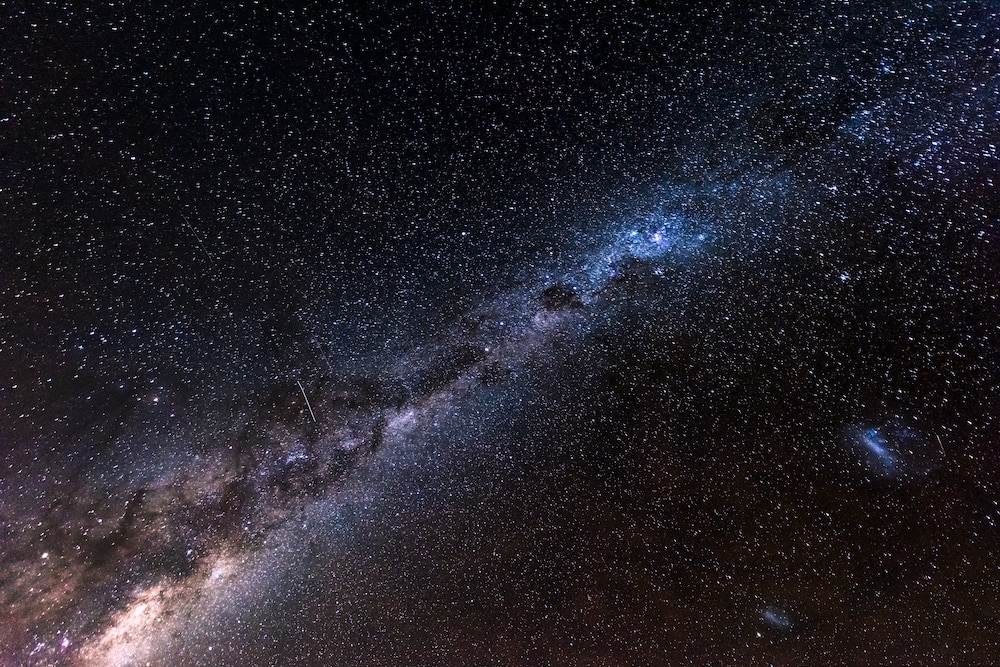Create a free profile to get unlimited access to exclusive videos, sweepstakes, and more!
Does the Milky Way eat dark matter for dessert?
Along with all the galaxies the Milky Way devours, it also swallows dark matter.

Stars can get caught in the gravitational jaws of galaxies, and the stars our own galaxy devours could literally shine more light on the mystery of dark matter.
To get as vast as it is, the Milky Way has not just eaten stars, but entire star systems. When its gravitational jaws ruthlessly shred stars, more is revealed about something otherwise invisible that is swallowed with rest. There is no actual way to detect or image dark matter. However, dark matter is what holds stars in their orbits, and while no star is bright enough to make it visible, the shapes of those orbits are the shape dark matter takes around those stars.
There are 12 stellar streams surrounding the Milky Way. Dark matter keeps the stars in these streams (really the dismembered corpses of smaller galaxies) from falling out of orbit, though they are often being attacked by the gravity of our galaxy and will eventually end up being eaten. Astronomer Ting Li of the University of Toronto, who led a study recently posted on the preprint server arXiv, and her research team have been autopsying these stellar bones.
“The big question about dark matter that we want to know the answer to is what is the nature of dark matter is,” Li told SYFY WIRE. “There are many proposed models of dark matter, but observing streams could help us differentiate from one dark matter model to another.”
Li and her research team created the Souther Stellar Stream Spectroscopic Survey (S5) to find out the properties of these stellar streams and what they could possibly tell us about dark matter. S5 uses the Anglo-Australian Telescope (AAT) and information from ESA’s Gaia mission to see the spectra of each star. Spectroscopy measures how much of each type of light is coming from an object to infer its properties, such as velocity and chemical composition. These were figured out from AAT observations, while Gaia observations helped remove surrounding objects and noise to identify specific target stars that belonged to stellar streams.
Gaia also measured transverse velocity — that is the part of a star’s velocity which is perpendicular to an observer’s line of sight. AAT came up with the radial velocities of those stars, which are the velocities seen along the telescope’s line of sight. 2D transverse velocity and 1D radial velocity add up to 3D velocity for each star in a stream. So what does this have to do with dark matter? How stars move in 3D gives a better idea of the stars’ orbits and how dark matter is shaping these orbits, meaning you don’t have to see it to see its effects.
“Some dark matter models also predict dark matter clumps, which we cannot see directly, in the Milky Way and other galaxies,” said Li. “But we think we could use star cluster streams to map out these ‘dark galaxies’ and prove or dispute certain dark matter models.”
Stellar streams could also give a more accurate read on the mass of the Milky Way. Depending on which dark matter model you’re looking at, it is probably going to give a different prediction for how many satellite galaxies are floating around the Milky Way, which is related to the mass of our galaxy. The dark matter clumps thought to lurk in space are thought to have once tried and failed to form stars. Though dark matter, being undetectable, cannot tell us about how stars evolved, there are other aspects of these stars that can take us through their evolution.
Spectra from stars can tell us the chemical composition and approximate age of stars depending on their absorption lines. These are usually seen as dark lines that result from light passing through a certain material that absorbs it, and when the light makes it through that material, dark lines show up in parts of the spectrum. The absorption lines Li looked for were from iron. They told her and her team how much iron was in a given star, and the less iron there was, the older the star, because there was not much iron around right after the Big Bang.
“The streams from disrupting star clusters can be used to search for these ‘dark galaxies’ which is also important as this is predicted by some dark matter models,” she said.
Even though we can see that our galaxy eats stars, think of dark matter like the hidden calories no one tells you about.


























